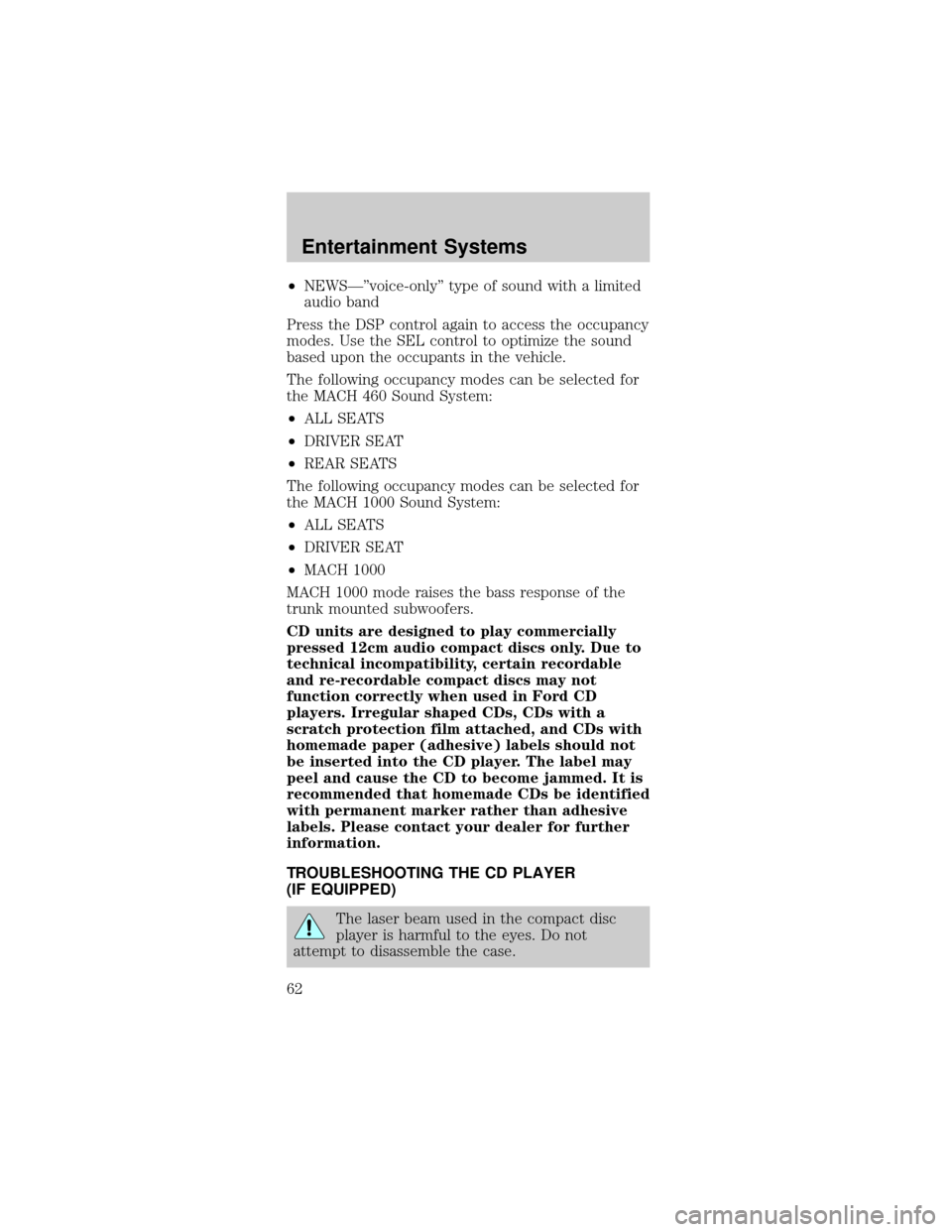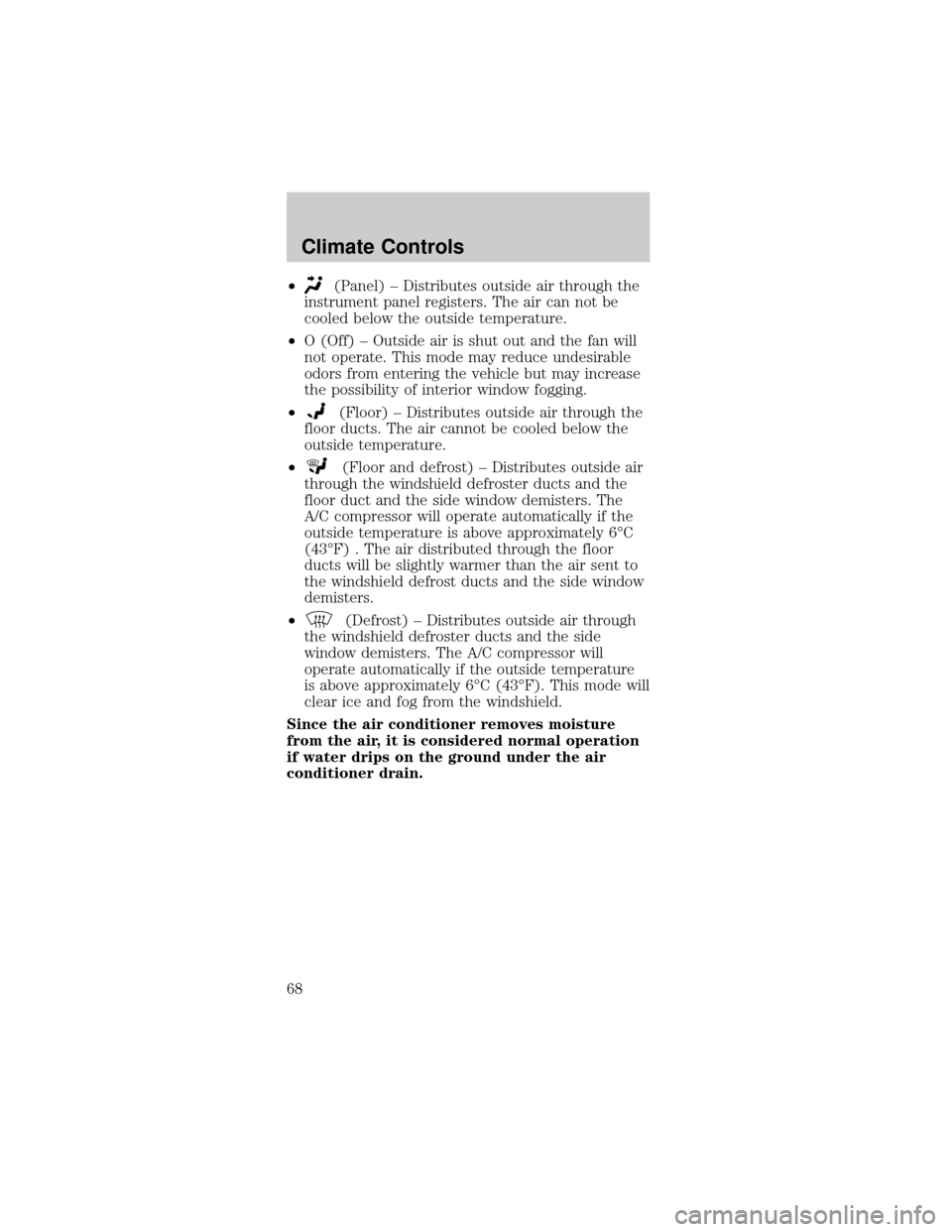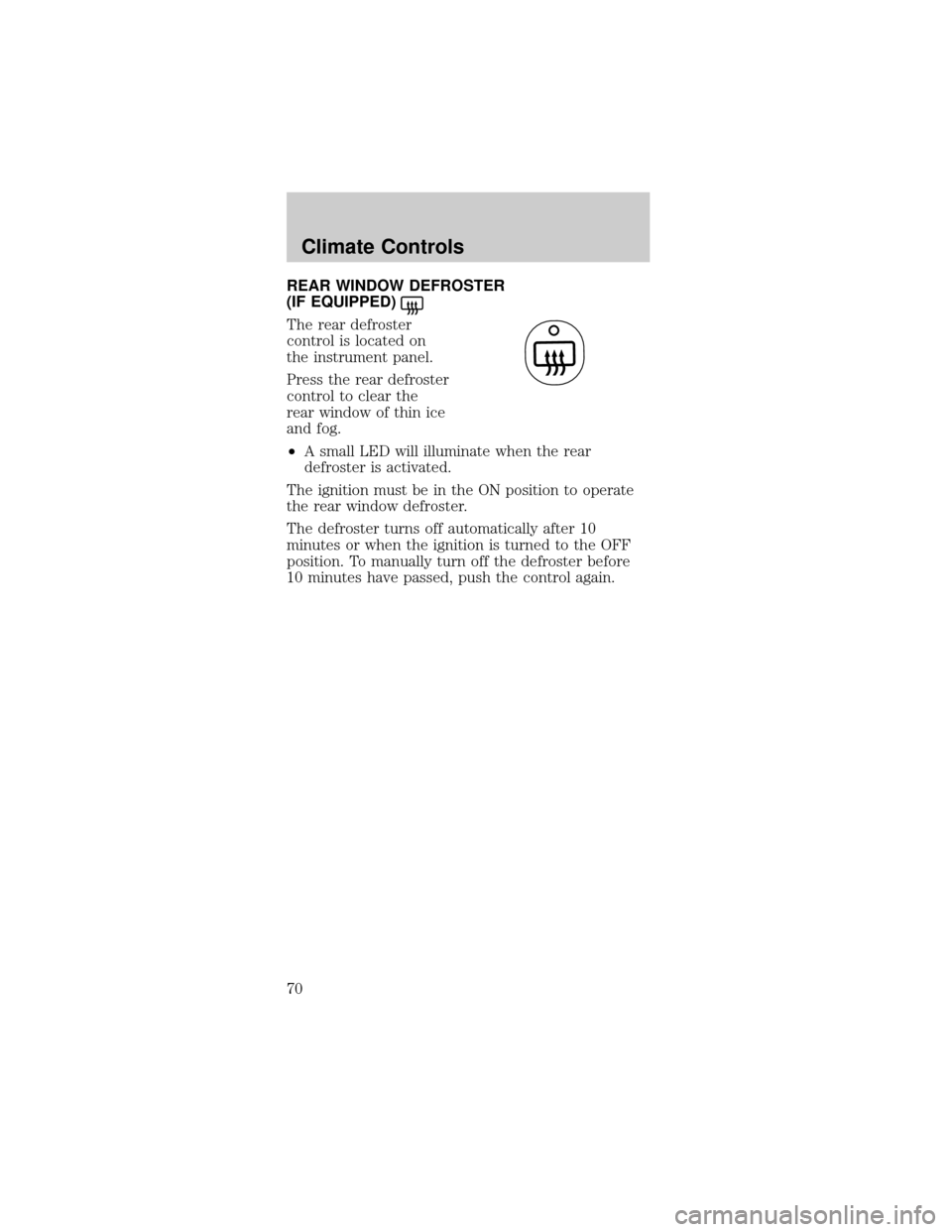FORD MUSTANG 2002 4.G Repair Manual
Manufacturer: FORD, Model Year: 2002, Model line: MUSTANG, Model: FORD MUSTANG 2002 4.GPages: 264, PDF Size: 2.56 MB
Page 61 of 264

Show
This feature allows you
to select the type of
RDS broadcast
information the radio
will regularly show in
the display.
With RDS activated,
press the MENU
control until SHOW is
displayed.
Use the SEL control to select TYPE (displays the
RDS program type: rock, jazz, etc), NAME (displays
the name of the radio station) or NONE (deactivates
the RDS display).
Digital signal processing
The digital signal processing (DSP) feature allows
you to change the signal mode to suit your listening
tastes.
Press the DSP control
to access the DSP
menu.
Use the SEL control to select the desired signal
mode (the selected mode will appear in the display).
The following can be selected:
²DSP
OFFÐdisengages
the feature
²STADIUMÐoutdoor
stadium with a capacity of about 30 000
²CHURCHÐchurch with a high vault
²HALLÐrectangular concert hall capacity of about
2 000
²JAZZ CLUBÐjazz club with clearly reflected
sounds
SEL+MENU
SEL
+MENU
DSP
SEL+
SEL
Entertainment Systems
61
Page 62 of 264

²NEWSкvoice-onlyº type of sound with a limited
audio band
Press the DSP control again to access the occupancy
modes. Use the SEL control to optimize the sound
based upon the occupants in the vehicle.
The following occupancy modes can be selected for
the MACH 460 Sound System:
²ALL SEATS
²DRIVER SEAT
²REAR SEATS
The following occupancy modes can be selected for
the MACH 1000 Sound System:
²ALL SEATS
²DRIVER SEAT
²MACH 1000
MACH 1000 mode raises the bass response of the
trunk mounted subwoofers.
CD units are designed to play commercially
pressed 12cm audio compact discs only. Due to
technical incompatibility, certain recordable
and re-recordable compact discs may not
function correctly when used in Ford CD
players. Irregular shaped CDs, CDs with a
scratch protection film attached, and CDs with
homemade paper (adhesive) labels should not
be inserted into the CD player. The label may
peel and cause the CD to become jammed. It is
recommended that homemade CDs be identified
with permanent marker rather than adhesive
labels. Please contact your dealer for further
information.
TROUBLESHOOTING THE CD PLAYER
(IF EQUIPPED)
The laser beam used in the compact disc
player is harmful to the eyes. Do not
attempt to disassemble the case.
Entertainment Systems
62
Page 63 of 264

If sound skips:
²You may be traveling on a rough road, playing
badly scratched discs or the disc may be dirty.
Skipping will not scratch the discs or damage the
player.
If your changer does not work, it may be that:
²A disc is already loaded where you want to insert
a disc.
²The disc is inserted with the label surface
downward.
²The disc is dusty or defective.
²The player's internal temperature is above 60ÉC
(140ÉF). Allow the player to cool down before
operating.
²A disc with format and dimensions not within
industry standards is inserted.
MP3 DISC QUALITY FACTORS
The MACHtMP3 music system is designed for use
with CD-DA (regular audio discs), CD-R and CD-RW
discs. Discs must comply with ISO 9660 and Joliet
standards.
Several factors can effect disc playback quality:
²Disc capacity Ð Each disc contains about 650 MB
of storage capacity. We do not recommend using
high capacity discs containing 700MB of storage.
²Disc type Ð Some CD-RW discs may operate
inconsistently and may cause an error message to
appear. We recommend burning MP3 files onto
CD-R discs.
²Disc finalization Ð The disc may be left open for
the purpose of adding sessions to it at a later
time, but be sure to close each session or the disc
will not play.
²Bit rate Ð The player supports bit rates from
56±320 kbps, as well as variable bit rate MP3 files,
but lower bit rates will have a noticeable effect on
Entertainment Systems
63
Page 64 of 264

sound quality and are recommended only for
speech or low fidelity music material. We
recommend that you encode MP3 files using a
high quality encoder.
²PC configuration Ð Encoding MP3 files requires
intensive use of your computer's resources. Follow
the PC configuration recommendations of the
encoder software vendor. We recommend that you
avoid running other software applications on your
PC during MP3 encoding to avoid undesirable
noise and distortion.
CLEANING COMPACT DISCS
Inspect all discs for contamination before playing. If
necessary, clean discs only with an approved CD
cleaner and wipe from the center out to the edge.
Do not use circular motion.
CD, MP3 AND CD PLAYER CARE
²Handle discs by their edges only. Never touch the
playing surface.
²Do not expose discs to direct sunlight or heat
sources for extended periods of time.
²Do not insert more than one disc into the slot of
the CD player (if equipped).
²Always store discs out of direct sunlight.
Excessive heat may damage or warp discs.
²Use care when handling and playing CD-R and
CD-RW discs, which are more susceptible to
damage from heat, light and stress than are
regular CDs.
²Always insert and remove a disc by holding the
disc flat, with the playing surface facing down, in
order to prevent damage to the disc or the player.
²Never insert any object other than a compact disc
into the player, as doing so may damage the
player and may cause injury to you.
Entertainment Systems
64
Page 65 of 264

²Do not disassemble the player. The laser used in
disc playback is extremely harmful to the eyes.
Do not insert any promotional (odd shaped or
sized) discs, or discs with removable labels into
the CD player as jamming may occur. Damage
incurred by adhesive materials of any kind or
non-standard discs may void the warranty.
CLEANING CASSETTE PLAYER (IF EQUIPPED)
Clean the tape player head with a cassette cleaning
cartridge after 10 to 12 hours of play in order to
maintain the best sound and operation.
CASSETTE AND CASSETTE PLAYER CARE
²Use only cassettes that are 90 minutes long or
less.
²Do not expose tapes to direct sunlight, high
humidity, extreme heat or extreme cold. Allow
tapes that may have been exposed to extreme
temperatures to reach a moderate temperature
before playing.
²Tighten very loose tapes by inserting a finger or
pencil into the hole and turning the hub.
²Remove loose labels before inserting tapes.
²Do not leave tapes in the cassette player for a
long time when not being played.
RADIO FREQUENCY INFORMATION
The Federal Communications Commission (FCC)
and the Canadian Radio and Telecommunications
Commission(CRTC) establish the frequencies AM
and FM stations may use for their broadcasts.
Allowable frequencies are:
AM 530, 540±1600, 1610 kHz
FM 87.7, 87.9±107.7, 107.9 MHz
Not all frequencies are used in a given area.
Entertainment Systems
65
Page 66 of 264

RADIO RECEPTION FACTORS
Three factors can affect radio reception:
²Distance/strength.The further an FM signal
travels, the weaker it is. The listenable range of
the average FM station is approximately 40 km
(24 miles). This range can be affected by ªsignal
modulation.º Signal modulation is a process radio
stations use to increase their strength/volume
relative to other stations.
²Terrain.Hills, mountains and tall buildings
between your vehicle's antenna and the radio
station signal can cause FM reception problems.
Static can be caused on AM stations by power
lines, electric fences, traffic lights and
thunderstorms. Moving away from an interfering
structure (out of its ªshadowº) returns your
reception to normal.
²Station overload.Weak signals are sometimes
captured by stronger signals when you pass a
broadcast tower. A stronger signal may
temporarily overtake a weaker signal and play
while the weak station frequency is displayed.
The audio system automatically switches to single
channel reception if it will improve the reception of
a station normally received in stereo.
AUDIO SYSTEM WARRANTIES AND SERVICE
Refer to theWarranty Guidefor audio system
warranty information.
If service is necessary, see your dealer or a qualified
technician.
Entertainment Systems
66
Page 67 of 264

MANUAL HEATING AND AIR CONDITIONING
SYSTEM
Fan speed control
Controls the volume of
air circulated in the
vehicle.
Temperature control knob
Controls the
temperature of the
airflow inside the
vehicle.
Mode selector control
Controls the direction
of the airflow to the
inside of the vehicle.
²MAX A/C ± Distributes recirculated air through
the instrument panel registers. The A/C
compressor will only function if the outside
temperature is above approximately 6ÉC (43ÉF).
MAX A/C is noisier than A/C, but more
economical and efficient. This mode may prevent
undesirable odors from entering the vehicle.
²A/C ± Distributes outside air through the
instrument panel registers. The A/C compressor
will only function if the outside temperature is
above approximately 6ÉC (43ÉF) .
MAX
A/CA/C
MAX
A/CA/C
Climate Controls
67
Page 68 of 264

²(Panel) ± Distributes outside air through the
instrument panel registers. The air can not be
cooled below the outside temperature.
²O (Off) ± Outside air is shut out and the fan will
not operate. This mode may reduce undesirable
odors from entering the vehicle but may increase
the possibility of interior window fogging.
²
(Floor) ± Distributes outside air through the
floor ducts. The air cannot be cooled below the
outside temperature.
²
(Floor and defrost) ± Distributes outside air
through the windshield defroster ducts and the
floor duct and the side window demisters. The
A/C compressor will operate automatically if the
outside temperature is above approximately 6ÉC
(43ÉF) . The air distributed through the floor
ducts will be slightly warmer than the air sent to
the windshield defrost ducts and the side window
demisters.
²
(Defrost) ± Distributes outside air through
the windshield defroster ducts and the side
window demisters. The A/C compressor will
operate automatically if the outside temperature
is above approximately 6ÉC (43ÉF). This mode will
clear ice and fog from the windshield.
Since the air conditioner removes moisture
from the air, it is considered normal operation
if water drips on the ground under the air
conditioner drain.
Climate Controls
68
Page 69 of 264

Operating tips
²To reduce fogging in humid weather, place the
climate control system in Defrost and Rear
Defrost mode (if equipped) before driving.
²To reduce humidity buildup inside the vehicle
under warm weather conditions, do not drive with
the climate control system in the Off mode.
²To reduce humidity buildup inside the vehicle
under cold weather conditions, do not drive with
the climate control system in Max A/C (if
equipped), recirculation mode (if equipped) or
Off mode.
²Under normal weather conditions, do not leave
your vehicle in the Max A/C (if equipped),
recirculation mode (if equipped) or Off mode
when turning off the vehicle.
²Under snowy or dirty weather conditions, leave
your vehicle in the Max A/C (if equipped),
recirculation mode (if equipped) or Off mode
when turning off the ignition.
²Remove any snow, ice or leaves from the exterior
base of the windshield.
²To increase the efficiency of the A/C (if
equipped), drive with the windows slightly open
for two to three minutes. or until the vehicle has
been ªaired outº.
²Do not place objects under the front seat or over
the defroster ducts. They may reduce visibility,
fall into the ducts, or degrade the performance of
your climate control system.
Do not place objects on top of the
instrument panel, as these objects may
become projectiles in a collision or sudden stop.
Climate Controls
69
Page 70 of 264

REAR WINDOW DEFROSTER
(IF EQUIPPED)
The rear defroster
control is located on
the instrument panel.
Press the rear defroster
control to clear the
rear window of thin ice
and fog.
²A small LED will illuminate when the rear
defroster is activated.
The ignition must be in the ON position to operate
the rear window defroster.
The defroster turns off automatically after 10
minutes or when the ignition is turned to the OFF
position. To manually turn off the defroster before
10 minutes have passed, push the control again.
Climate Controls
70